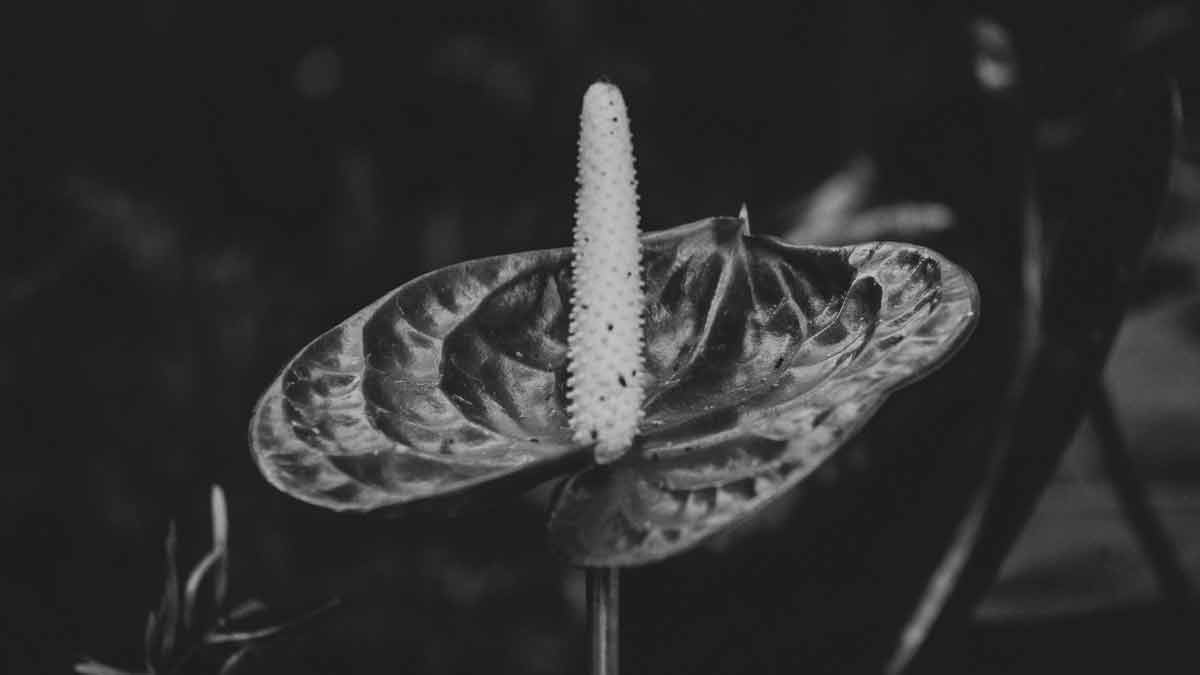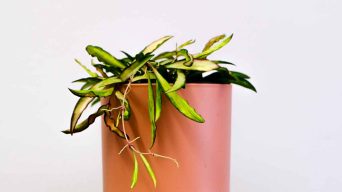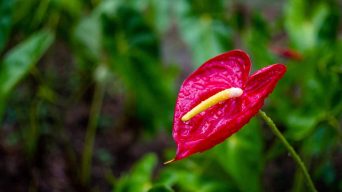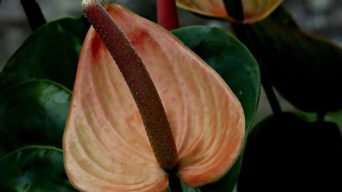Underwatering an Anthurium leads to drooping leaves, browning, and slow growth. To revive, water appropriately, prune, and transplant if needed. Prevent by using well-draining soil, ensuring proper drainage, consistent watering, and controlling humidity levels.
Anthurium plants are popular among plant enthusiasts with their stunning, vibrant blooms and lush foliage.
But just like any other living thing, they can struggle without proper care.
One common issue is underwatering.
Here we’ll explore how to identify an underwatered Anthurium and discuss effective solutions to treat and prevent this problem from recurring.
Signs Of An Underwatered Anthurium
Anthuriums are popular indoor plants with beautiful flowers but require proper care to thrive.
If you notice drooping leaves and flowers, brown or yellow leaves, and slow growth in your Anthurium, it may be a sign that your plant is not getting enough water.
Understanding the signs of an underwatered Anthurium can help you adjust your watering schedule and keep your plant healthy.
Drooping Leaves And Flowers
Drooping leaves and flowers are one of the most apparent signs that your anthurium plant is not receiving sufficient water.
This lack of hydration causes the cells within the leaves and stems to lose turgidity, resulting in a limp or wilted appearance.
In many instances, underwatering can be mistaken for overwatering since both conditions cause drooping; however, other symptoms can help determine whether your Anthurium needs more or less water.
For example, if you notice that alongside drooping leaves and flowers, there is browning at the leaf tips along with slow growth rates or yellowing foliage, this may indicate that the lack of water is negatively impacting your tropical plant’s health.
Brown Or Yellow Leaves
Brown or yellow leaves are often one of the first visible indicators that your Anthurium plant is underwatered.
This common issue can occur in various types of Anthuriums, including indoor tropical plants like Anthurium crystallinum and queen anthurium (Anthurium warocqueanum).
The discolored leaves are typically a result of the plant not receiving enough water to sustain its growth, causing it to draw moisture from older leaves as a survival mechanism.
Several factors may lead to brown or yellow leaves on your underwatered anthurium plants.
One such factor is placing them in direct sunlight for too long, which can cause leaf scorching and further exacerbate the problem.
Low humidity levels in your home environment can also contribute to discolored foliage due to increased moisture loss through transpiration.
Slow Growth
One of the key indications that your anthurium plant is underwatered is slow growth.
Whether you have a stunning queen anthurium or a tropical Anthurium crystallinum, all varieties require adequate moisture to thrive and grow optimally.
When underwatered, these plants cannot efficiently take up nutrients from the soil, resulting in stunted growth and lackluster leaves.
How To Treat An Underwatered Anthurium
You must take a few essential steps to nurse an underwatered Anthurium back to health.
The first step is properly watering the plant, ensuring the soil is moist but not overwatered.
After that, prune any damaged roots and repot the Anthurium in fresh soil with good drainage.
To promote healthy growth, fertilize the plant regularly using a balanced fertilizer.
Follow these simple steps, and your Anthurium will soon be thriving again.
Watering Correctly
When watering your Anthurium plant, finding the right balance between keeping the soil moist and preventing overwatering is crucial.
Here are some tips on how to water your Anthurium correctly:
- Test the soil moisture regularly: Use a finger or a moisture meter to check the top 1-2 inches of soil for dryness. If it feels dry, it’s time to water.
- Water thoroughly: When you water your Anthurium, ensure you soak the soil thoroughly until excess water drains out of the bottom of the pot.
- Avoid letting the soil dry out completely: While it’s crucial not to overwater your Anthurium plant, allowing the soil to dry out completely can cause stress and damage. Keep an eye on the moisture level and aim for consistently moist but not soggy soil.
- Consider humidity: Anthuriums thrive in humid environments, so adding a pebble tray or misting occasionally can help keep them healthy.
- Adjust watering during growth cycles: During active growth periods, like spring and summer, your Anthurium may require more frequent watering than in fall and winter, when they tend to slow down.
Pruning
Pruning is essential for every Anthurium owner to maintain a healthy plant.
Here are some tips to help you correctly prune your Anthurium:
- Remove yellow, wilted, or brown leaves and flowers with clean and sharp scissors or shears as soon as possible.
- Trim the stem of the Anthurium by cutting it just above a new shoot or bud.
- Use sterile pruning tools to prevent the spread of diseases between plants.
- Do not cut too much at once; do it gradually over time to avoid stressing the plant.
- Prune annually during spring when growth resumes after a dormant period, and remove any dead growth from the previous year.
Remember that proper pruning will promote new growth and increase flowering in your Anthurium.
Transplanting
Transplanting an Anthurium plant is a great way to revive it if it’s suffering from root rot or overcrowded roots.
Here’s how to transplant an Anthurium:
- Select a pot one size larger than the current one with drainage holes at the bottom.
- Fill the pot with a well-draining soil mix, such as sphagnum moss, peat moss, and orchid bark.
- Carefully remove the plant from its old container and gently loosen any tangled roots.
- Place the Anthurium in the new pot, ensuring that the top of its roots sits just below the pot’s rim.
- Backfill soil around the sides of the root ball until it’s level with or slightly below the top of the pot.
- Water thoroughly, but avoid saturating the soil, which can lead to overwatering.
Transplanting allows you to carefully inspect your plant’s roots and prune away any damaged or dead ones.
You may also replace some portions of soil if you notice signs of poor drainage, such as water pooling on top of it after watering.
It’s best to transplant an Anthurium during its growing season in spring, when it will have ample time to adjust before winter dormancy hits.
Finally, be mindful not to place your freshly transplanted Anthurium in direct sunlight but rather in bright indirect light until it fully recovers from transplant shock – usually taking 1-2 weeks.
Fertilizing
Fertilizing your Anthurium plant is critical to keep it healthy and thriving.
Here are some essential tips to help you fertilize your underwatered Anthurium:
- Choose the right fertilizer for your plant: Use a high-quality fertilizer formulated for Anthurium plants. Look for a balanced fertilizer that contains equal amounts of nitrogen, phosphorus, and potassium (N-P-K) or a slightly higher amount of potassium.
- Apply fertilizer in the growing season: To promote healthy growth, apply fertilizer during the growing season (spring and summer). Avoid fertilizing during winter when the plant’s growth slows down.
- Follow directions carefully: Always read the instructions on the fertilizer package carefully before use. Avoid using too much fertilizer, as this can burn the roots of your Anthurium plant.
- Apply fertilizer evenly: Water your plant lightly before applying the fertilizer to avoid burning its roots. Apply the recommended amount of fertilizer evenly across the soil surface.
- Consider homemade options: You can make your own organic fertilizers at home using ingredients like banana peels, eggshells, or coffee grounds, which add nutrients to the soil over time.
How To Prevent An Anthurium From Being Underwatered
To ensure a healthy Anthurium plant, it is crucial to prevent it from being underwatered.
This can be achieved by taking certain measures such as selecting appropriate soil, ensuring proper drainage, maintaining consistent watering, and managing humidity levels.
By following these steps, your Anthurium plant will survive and thrive.
Choosing The Right Soil
Choosing the right soil is one of the most critical steps in preventing an Anthurium from being underwatered.
The type of soil that you use will play a significant role in how well your plant thrives.
Ideally, you want to use a well-draining and acidic soil mix that allows for proper water retention without becoming waterlogged.
Avoid using plain garden soil or soils with poor drainage, as they can lead to root rot and other issues.
One great option for Anthuriums is to use a mixture of sphagnum moss, peat moss, orchid bark, and perlite.
This combination allows for excellent drainage while retaining moisture so your plant stays hydrated.
Another thing to consider when choosing your soil is the pH level. Most Anthuriums prefer slightly acidic soil with a pH range between 5.5-6.5.
In addition to choosing the right type of soil mix, it’s also important to ensure adequate drainage holes at the bottom of your pot to allow excess water to escape easily.
Stagnant water can accumulate around roots without proper drainage, leading to root rot or fungal diseases, which can cause Anthurium leaves to turn brown and yellow prematurely.
Proper Drainage
Proper drainage is essential for Anthurium plants to thrive.
Here are some tips on how to ensure that your Anthurium has proper drainage:
- Choose a pot with a drainage hole: When selecting a pot for your Anthurium, always choose one with a drainage hole at the bottom. This ensures that excess water can drain out of the soil and prevent overwatering.
- Use well-draining soil: Use a well-draining soil mix that includes orchid bark, peat moss, and sphagnum moss. Avoid using heavy soils that retain moisture for long periods.
- Add rocks or gravel at the bottom of the pot: Placing stones or gravel at the bottom before adding soil can help improve drainage.
- Monitor humidity levels: High humidity levels can cause soil to remain moist, leading to root rot and other problems. It’s important to monitor humidity levels closely and adjust accordingly.
- Repot when necessary: Anthurium’s roots may become crowded over time and restrict proper drainage. Repotting your plant every 1-2 years in fresh soil helps promote healthy root growth and improves overall plant health.
Consistent Watering
Consistent watering is crucial to keep Anthurium plants healthy and prevent them from being underwatered.
Here are some tips for consistent watering:
- Water your Anthurium once a week or whenever the top inch of the soil feels dry.
- Use room-temperature water to avoid shocking the plant’s roots.
- Water your Anthurium thoroughly, allowing water to flow out of the drainage hole at the bottom of the pot.
- Avoid overwatering or leaving your Anthurium in standing water, leading to root rot and other diseases.
- During hot, dry months or if your Anthurium is in direct sunlight, you may need to increase the watering frequency or use a humidifier to maintain proper moisture levels.
- If you have trouble remembering when to water your Anthurium, set a reminder on your phone or calendar.
Remember that every plant has unique watering needs based on size, growing season, and location.
You can consistently monitor and adjust your watering schedule as needed to help your Anthurium thrive for years.
Humidity Control
Maintaining the proper humidity level is crucial for the healthy growth of Anthurium plants.
Here are some tips to help you control humidity levels:
- Create a high humidity environment: Anthurium plants thrive at 80% or more high humidity levels. You can create a high-humidity environment by placing your plant on a tray filled with pebbles and water. The water evaporates, increasing the humidity around the plant.
- Grouping Plants: Grouping several plants can increase humidity in a small space by releasing moisture through transpiration.
- Use a Humidifier: A humidifier can also maintain an ideal humidity level for your Anthurium plant. It adds moisture to the air, providing adequate hydration to your plants.
- Avoid Overwatering: Overwatering can lead to low-humidity conditions, damaging your plants’ leaves and roots and making them more prone to pests and diseases. Be sure to water your Anthurium correctly, follow its watering needs based on soil moisture levels, and let it dry out slightly before watering again.
- Mist Your Plants Regularly: Misting effectively increases humidity around Anthuriums without causing waterlogging or rotting issues. Use a spray bottle filled with water to mist lightly over the leaves and flower surface every morning or evening.
- Use Soil Moisture Meter: Invest in a soil moisture meter that measures environmental factors such as soil pH, temperature, light levels, and relative humidity – this will help you keep up with optimal conditions for your Anthurium plant.
Final Thoughts
Maintaining the proper moisture levels and providing adequate care is vital for the well-being of your Anthurium plant.
Underwatering can lead to droopy leaves and brown spots, while overwatering can cause root rot and uncontrolled growth.
Following simple steps such as choosing the right soil mix, providing proper drainage, and consistent watering coupled with fertilizing and pruning will keep your Anthurium healthy all year round.
Regular monitoring can help detect common issues before they become more significant problems that need more challenging solutions.
With some love and attention, your beautiful tropical Anthurium will thrive in its new environment!







